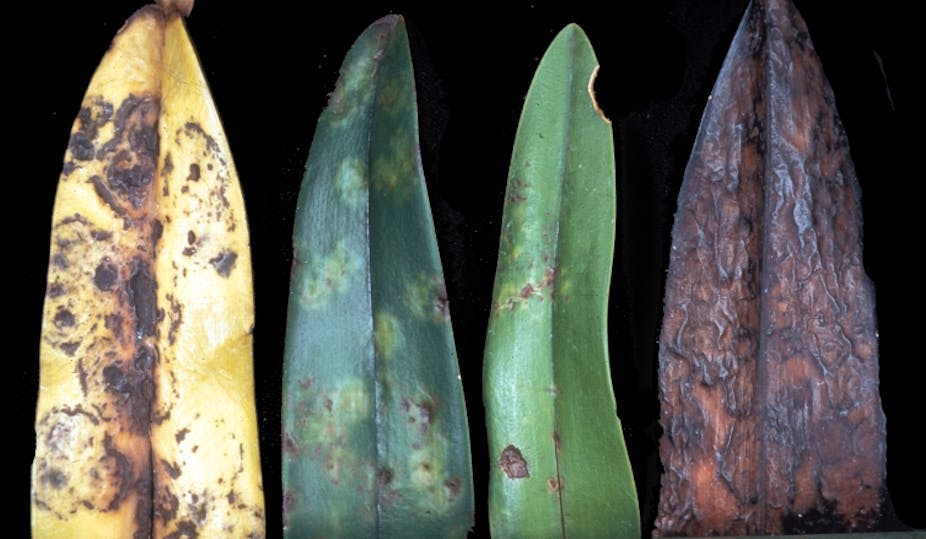Plant viruses are sub-microscopic parasites that have been studied primarily because they cause devastating diseases in crop plants. But in recent years, scientists have discovered they’re not just bad news; they also form symbiotic relationships with plants and the microbes they host.
Moreover, plant virus genomes have been engineered for use in gene delivery and are also being increasingly used as nanoparticles in bio-nanotechnology.
A range of symptoms
More than 1000 virus species have been described that infect cultivated plants worldwide. They have the capacity to cause major epidemics and total crop loss, which is particularly devastating in developing countries that depend on a few staple crops for food security and income. For example, the Cassava Mosaic Disease epidemic in many African countries is caused by several species of Begomoviruses, including African Cassava Mosaic Virus. These are transferred from plant to plant by whiteflies.

Often viruses do not completely destroy crops but decrease their yield and quality. In fruit and vegetable crops, Plum pox virus affects stone fruit trees, while Tomato spotted wilt and Tomato yellow leaf curl viruses cause severe losses in tomatoes. Potato virus Y affects potatoes and many vegetables.
Even more benign viruses can build up in planting material of crops propagated through cuttings, roots or tubers. This leads to degeneration and yield losses in subsequent growing seasons. In potato production systems, virus incidence can be high with tubers infected with five or six different viruses. Such degeneration depresses both yield and quality. Studies in sub-Saharan Africa have shown that yield increases of 30-50% are possible when farmers replenish their stock with healthy planting material.

However, in the past not all virus symptoms were thought to be bad. The symptoms of Tulip breaking virus – broken colour on the petals – can be seen in the 17th century paintings of Dutch masters, for example. At that time, bulbs giving rise to such flowers were highly prized. It was only in the 20th century that these bulbs were known to be infected with a virus.
Plant viruses can be detected by fast and sensitive laboratory methods. In addition, virus spread can be controlled with pesticides which kill the natural vectors such as insects or nematodes that transmit viruses from plant to plant. Many types of insects transmit viruses, including aphids, thrips and whiteflies – and their populations are increasing in size and geographic range, an effect expected to increase with global warming. For that reason host resistance is the most sustainable and effective way to control viruses in crop plants.
Good viruses
Recent studies have shown that many plants in natural populations are infected with viruses – many of which cause no obvious symptoms but persist and are transmitted by seed to subsequent generations. The reason for these cryptic virus-host associations is not yet clear. However, as occurs in other host-virus interactions in mammals or bacteria, some viruses can exist in symbiotic association and have a beneficial effect. A good example is a study of tropical panic grass growing in Yellowstone National Park where the soil temperature can exceed 50°C. The grass can only tolerate these conditions through a symbiotic association with a fungus infected with a virus.
Several disease-causing plant viruses can also protect their host plants from abiotic stresses such as cold or drought conditions. Plants infected with Cucumber mosaic, Brome mosaic and Tobacco mosaic viruses tolerate drought conditions better than uninfected plants. Tobacco mosaic virus was first recognised as an infectious agent in 1898 and research on it continues to push the boundaries of knowledge, including in bio-nanotechnology.
Plant viruses are natural nanoparticles, and viruses such as the tubular rod-shaped Tobacco mosaic virus and icosahedral Cowpea mosaic virus have been used in a number of applications. By genetically manipulating the virus genomes and inserting gene coding for other molecules, scientists have managed to make host plants infected with the virus produce additional molecules. The molecules can be expressed fused to the surface of the virus particles or expressed as free protein. We can then harvest the leaves of the plants and purify the molecules for vaccines or other valuable pharmaceuticals.
An emerging area is to use virus particles as “nanoscaffolds”. Here, the particle surfaces are genetically or chemically altered and certain compounds, peptides and enzymes are added. For example, nano structures based on the Tobacco mosaic virus can stabilise magnetic liquids in transistor components. In fact, the future use of plant viruses as components in materials-, plant- and biomedical sciences is only limited by our imagination.

